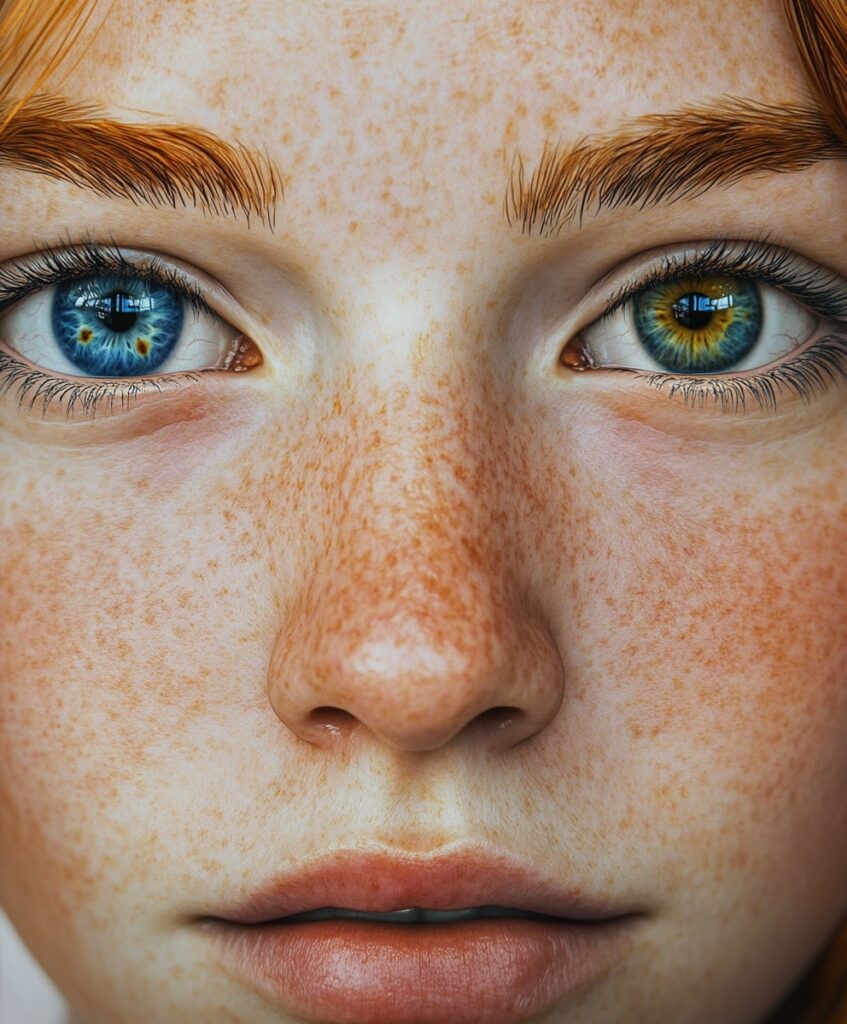Heterochromia
Ihr Leitfaden, Informationen und Tipps
Introduction to Heterochromia
Heterochromia, derived from the Greek words héteros (different) and chrôma (color), is a fascinating condition characterized by variations in eye color. This phenomenon most commonly refers to differences in the pigmentation of the iris, though it can also affect hair or skin. Heterochromia occurs in less than 1% of the human population, making it a rare and captivating anomaly. In the United States, fewer than 200,000 people are affected, classifying it as uncommon according to the National Organization for Rare Disorders.
The condition is caused by variations in melanin production, the pigment responsible for the color of skin, eyes, and hair. Depending on whether the melanin is overproduced (hyperpigmentation) or underproduced (hypopigmentation), the affected iris can appear lighter or darker.
Heterochromia is broadly categorized into three types:
- Complete Heterochromia: One eye is entirely different in color from the other.
- Sectoral Heterochromia: A portion of the iris in one or both eyes differs in color from the rest.
- Central Heterochromia: The iris exhibits a ring of color around the pupil, distinct from the outer iris color.
While most cases of heterochromia are harmless and genetically inherited, others may stem from trauma, disease, or medication use, making it an area of interest in ophthalmology. For instance, studies highlight a link between acquired heterochromia and conditions like glaucoma or iritis, demonstrating the importance of distinguishing benign cases from medically significant ones.
Heterochromia has also been observed across species, being notably prevalent in animals such as Siberian Huskies, Turkish Van cats, and horses. This raises intriguing questions about the genetic pathways shared by humans and animals, which will be explored further in this article.
From its genetic origins to its cultural significance, this comprehensive guide delves into the science, symbolism, and unique beauty of heterochromia. Whether you are curious about its causes or fascinated by its occurrence in celebrities and pets, this article aims to illuminate the many facets of this remarkable condition.
Key Takeaways of Heterochromia
| Outline Section | Key Takeaway |
|---|
| 1. Introduction to Heterochromia | Heterochromia is a rare condition affecting <1% of the population, involving differences in eye coloration. |
| 2. Types of Heterochromia | The three types—complete, sectoral, and central—vary in their appearance and underlying causes. |
| 3. Causes of Heterochromia | Caused by genetic factors, diseases, or injuries; melanin concentration and distribution play a major role. |
| 4. Genetics Behind Heterochromia | At least 16 genes regulate eye color, with mutations or mosaicism leading to heterochromia. |
| 5. Cultural and Historical Perspectives | Heterochromia has been both admired and mystified in history, often linked to unique or otherworldly traits. |
| 6. Risks Associated with Heterochromia | While most cases are benign, some may indicate underlying conditions like Waardenburg syndrome or Horner’s. |
| 7. Heterochromia in Animals | Common in domestic animals like cats and dogs, often linked to coat patterns or genetic traits. |
| 8. Future Research Directions | New genetic studies could unlock deeper insights into heterochromia and its links to health and eye color. |
Types of Heterochromia: A Detailed Overview
Heterochromia presents itself in three primary forms, each with distinct characteristics. Understanding these variations is essential for diagnosing, appreciating, and distinguishing this condition across individuals.
1. Complete Heterochromia
This type is the most visually striking. One iris is a completely different color than the other. For example, one eye may be deep brown while the other is vibrant blue.
- Frequency: This form is the rarest in humans but more commonly observed in animals, particularly in certain breeds of dogs (e.g., Siberian Huskies) and cats (e.g., Turkish Van).
- Mechanism: Complete heterochromia arises from a significant melanin disparity in the irises, either due to genetic factors, trauma, or developmental anomalies.
- Famous Cases: Celebrities like David Bowie (though his was acquired due to an eye injury) and Alice Eve showcase the unique charm of complete heterochromia.
2. Sectoral Heterochromia
Also known as partial heterochromia, this type is characterized by two distinct colors within the same iris.
- Appearance: A portion of the iris has a different hue, often forming a radial or pie-shaped segment.
- Prevalence: Less common in humans, sectoral heterochromia is more frequent in animals with merle or piebald coat patterns, such as Australian Shepherds.
- Causes: This condition typically results from mosaicism (when cells carry different genetic information), inherited traits, or postnatal injuries.
- Example: A person might have a predominantly green iris with a sector of golden brown.
3. Central Heterochromia
This form is marked by a color gradient radiating outward from the pupil. Often, the central zone of the iris contrasts with the outer ring.
- Common Traits: Central heterochromia is more prevalent in lighter-colored eyes, such as blue or hazel, where the color contrast is more noticeable.
- Causes: It often results from variations in melanin distribution within the iris layers.
- Unique Effect: This type is frequently described as “cat-like” due to the multi-tonal complexity of the eye.
- Observation: For example, an iris may have a golden or amber center transitioning to green or blue on the outer edges.
Visual Guide to Heterochromia Types
- Complete: Brown vs. blue (one eye entirely different from the other).
- Sectoral: A blue iris with a brown segment.
- Central: A hazel eye with a golden ring encircling the pupil.
Each type of heterochromia, while rooted in similar biological principles, offers a distinct visual signature, making it a captivating study in ocular genetics and beauty. These types will later be examined in the context of their causes, cultural significance, and potential health implications.
Causes of Heterochromia: Genetic and Acquired
Genetic Origins: Congenital Heterochromia and Hereditary Patterns
Congenital heterochromia is present at birth and is often rooted in genetic factors. It arises due to mutations or variations in genes that regulate the production of melanin, the pigment responsible for coloring the skin, hair, and eyes. An uneven distribution or production of melanin in the iris leads to different eye colors between the two eyes or within the same eye.
A well-known genetic condition associated with heterochromia is Waardenburg syndrome. This rare hereditary disorder affects approximately 1 in 40,000 people worldwide. It is characterized by pigmentary abnormalities of the eyes, hair, and skin, along with hearing loss. Mutations in specific genes like PAX3, MITF, or SOX10 disrupt the development and function of melanocytes, the cells that produce melanin.
Acquired Heterochromia: Causes Like Trauma, Disease, or Medications
Acquired heterochromia develops after birth and can result from various external factors:
- Trauma: Injuries to the eye from accidents or surgical procedures can impair melanin production in the iris. Studies indicate that about 5% of heterochromia cases are due to ocular injuries.
- Disease: Certain medical conditions can cause heterochromia. For instance, Horner’s syndrome results from damage to the sympathetic nerves of the face and eye, leading to decreased pigmentation in the affected iris. Uveitis, an inflammation of the middle layer of the eye (uvea), can also induce color changes.
- Medications: Long-term use of certain eye medications, particularly prostaglandin analogs used to treat glaucoma (increased pressure in the eye), may lead to darkening of the iris over time.
The Science of Melanin Production and Its Disruption
Eye color is determined by the amount and distribution of melanin within the iris. Melanin exists in two forms: eumelanin (dark brown to black pigment) and pheomelanin (red to yellow pigment). The balance between these pigments affects the hue of the iris.
In heterochromia, the function of melanocytes is altered:
- Hyperpigmentation: Excessive melanin production causes a darker iris color.
- Hypopigmentation: Reduced melanin production leads to a lighter iris color.
Disruptions can stem from genetic mutations, inflammatory processes, or physical damage to the eye. Research published in the Journal of Medical Genetics in 2018 highlighted the role of mutations in the OCA2 gene, which is crucial for melanin synthesis, in causing variations in eye color, including heterochromia.
Understanding the underlying causes of heterochromia is essential not only for aesthetic reasons but also because it can be a sign of underlying health issues that may require medical attention.

The Science Behind Heterochromia
How Melanin Concentration and Genetic Mutations Influence Eye Pigmentation
Eye color is primarily determined by the concentration and distribution of melanin within the iris, the colored part of the eye. Melanin is a natural pigment produced by specialized cells called melanocytes, which also contribute to skin and hair color. There are two types of melanin involved:
- Eumelanin: Provides brown to black pigmentation.
- Pheomelanin: Offers red to yellow pigmentation.
The combination and amount of these pigments, along with the scattering of light in the iris stroma (a phenomenon known as the Tyndall effect), result in the spectrum of human eye colors ranging from light blue to dark brown.
In heterochromia, variations in melanin concentration between the two eyes or within different parts of the same iris lead to differences in eye color. These variations can be caused by genetic mutations that affect melanocyte function or distribution.
Genetic Mutations and Their Impact
Several genes play crucial roles in eye pigmentation by regulating melanin production and melanocyte development. Mutations or variations in these genes can lead to heterochromia:
- OCA2 Gene: Influences melanin synthesis. Mutations here can result in conditions like oculocutaneous albinism, leading to reduced pigmentation in the eyes, skin, and hair.
- HERC2 Gene: Regulates the expression of the OCA2 gene. Certain variations are associated with blue eye color due to decreased melanin production.
- MITF Gene: Essential for the development and function of melanocytes. Mutations can cause pigmentary disorders and are linked to Waardenburg syndrome, which features heterochromia among its symptoms.
A study published in the American Journal of Human Genetics (2020) identified specific mutations in the MITF gene that disrupt melanocyte development, leading to heterochromia and other pigmentation anomalies.
Syndromes and Conditions Associated with Heterochromia
Heterochromia can be an isolated trait or part of a syndrome involving other medical conditions. Notable syndromes include:
- Neurofibromatosis Type 1 (NF1): A genetic disorder affecting about 1 in 3,000 individuals globally. Characterized by tumors along nerves in the skin, brain, and other parts of the body. Iris abnormalities, such as Lisch nodules (benign growths), can alter pigmentation and cause heterochromia.
- Horner’s Syndrome: Results from damage to the sympathetic nerves of the face and eye. Symptoms include a drooping eyelid (ptosis), a constricted pupil (miosis), and decreased sweating on one side of the face (anhidrosis). Congenital Horner’s syndrome can lead to heterochromia due to reduced melanin synthesis in the affected eye.
- Sturge-Weber Syndrome: A rare vascular disorder present at birth, characterized by a facial port-wine stain and neurological abnormalities. Ocular involvement may include heterochromia and an increased risk of glaucoma.
Differences in Hyperpigmentation vs. Hypopigmentation
Heterochromia arises from either an excess or deficiency of melanin in the iris:
- Hyperpigmentation (Darker Iris):
- Causes: Increased melanin production due to conditions like ocular melanosis or prolonged use of certain medications (e.g., prostaglandin analogs for glaucoma treatment).
- Mechanism: Excessive activity of melanocytes leads to a darker iris color.
- Hypopigmentation (Lighter Iris):
- Causes: Reduced melanin production from genetic conditions like albinism or damage to melanocytes due to inflammation.
- Mechanism: Decreased melanin synthesis results in a lighter iris color.
A study in Investigative Ophthalmology & Visual Science (2019) demonstrated that inflammatory processes could damage melanocytes in the iris, leading to hypopigmentation and contributing to conditions like Fuchs heterochromic iridocyclitis, which is associated with heterochromia.
The Role of Melanocyte Function and Development
Melanocytes originate from neural crest cells during embryonic development. Disruptions in their migration, proliferation, or function can result in pigmentary disorders:
- Embryonic Development Issues: Faulty migration of melanocytes can leave areas of the iris with fewer pigment-producing cells, leading to heterochromia.
- Genetic Regulation Errors: Mutations in genes like PAX3, SOX10, and KIT affect melanocyte survival and function, contributing to syndromic forms of heterochromia.
Research published in the Journal of Clinical Genetics (2021) highlighted mutations in the SOX10 gene that not only lead to heterochromia but also impact auditory function, demonstrating the interconnected nature of melanocyte-related conditions.
Environmental and Acquired Factors
Beyond genetics, external factors can influence melanocyte activity:
- Physical Trauma: Injuries to the eye can damage melanocytes or alter melanin distribution, leading to acquired heterochromia.
- Medications and Chemicals: Certain substances can stimulate or inhibit melanin production. For example, prostaglandin analogs used in glaucoma treatment can increase melanin synthesis in the iris.
- Inflammatory Diseases: Conditions like uveitis cause inflammation that may disrupt melanocyte function and melanin deposition.
Current Research and Clinical Implications
Understanding the science behind heterochromia is crucial for:
- Diagnostic Purposes: Identifying underlying genetic conditions that may have broader health implications.
- Treatment Strategies: Developing interventions for associated symptoms, such as managing glaucoma risk in Sturge-Weber syndrome.
- Genetic Counseling: Providing information to families about the inheritance patterns and risks of syndromic conditions linked to heterochromia.
Advancements in genetic testing and imaging technologies continue to enhance our comprehension of heterochromia’s underlying mechanisms, leading to better patient outcomes and personalized care approaches.
Back
Greyblue
Ravi
Sapphire Blue
“Heterochromia: The rare and captivating phenomenon of different colored eyes, blending genetics, health insights, and cultural significance across species.”
Risks Associated with Heterochromia
Medical Risks: Conditions Linked to Acquired Heterochromia
While heterochromia is often harmless, especially when present from birth, acquired heterochromia can sometimes signal underlying medical issues that require attention. Several conditions are associated with changes in iris pigmentation:
Glaucoma: A group of eye diseases characterized by damage to the optic nerve, often due to increased intraocular pressure. Certain medications used to treat glaucoma, such as prostaglandin analogs, can cause the iris to darken over time. According to the World Health Organization, glaucoma affects approximately 76 million people worldwide and is a leading cause of irreversible blindness.
Uveitis: An inflammation of the uveal tract, which includes the iris, ciliary body, and choroid. Uveitis can lead to tissue damage and changes in eye color. It accounts for about 10% of blindness cases in the United States. Symptoms may include eye redness, pain, blurred vision, and light sensitivity.
Eye Tumors: Neoplasms like melanoma of the iris can alter melanin production, leading to heterochromia. Although rare—with an incidence of about 5 cases per million people annually—iris melanoma is a serious condition that requires prompt medical intervention.
Vision Concerns: Potential Impact on Sight or Light Sensitivity
Heterochromia itself typically does not impair vision. However, if it’s a symptom of an underlying condition, there may be associated visual problems:
Photophobia (Light Sensitivity): Differences in iris pigmentation can affect how much light enters each eye, potentially causing discomfort in bright environments.
Visual Disturbances: Conditions like uveitis or glaucoma not only alter eye color but can also lead to blurred vision, floaters, or even vision loss if left untreated.
When Heterochromia Signals a More Serious Underlying Health Issue
Sudden changes in eye color warrant immediate medical evaluation. Acquired heterochromia can be a sign of systemic diseases or neurological disorders:
Horner’s Syndrome: Resulting from damage to the sympathetic nerves of the face and eye, this condition can cause a drooping eyelid (ptosis), a constricted pupil (miosis), and decreased sweating on one side of the face (anhidrosis), along with heterochromia in some cases. It may indicate serious issues like a carotid artery dissection or tumors in the upper lung.
Fuchs Heterochromic Iridocyclitis: A chronic inflammation of the iris and ciliary body, leading to heterochromia, cataract formation, and an increased risk of glaucoma. It is responsible for about 1-3% of uveitis cases.
Neuroblastoma: A cancer that develops from immature nerve cells and most commonly affects infants and young children. Ocular involvement can lead to heterochromia due to disruption of sympathetic nerve pathways.
Importance of Medical Evaluation
Given that heterochromia can be associated with serious health conditions, it is crucial to consult an ophthalmologist if you notice changes in your eye color, especially if accompanied by other symptoms like pain, vision changes, or signs of systemic illness.
Comprehensive Eye Exam: Includes a thorough inspection of the eyes using a slit lamp to examine the anterior structures and tonometry to measure intraocular pressure.
Imaging Studies: MRI or CT scans may be necessary if a neurological cause is suspected, particularly in cases of Horner’s syndrome.
Laboratory Tests: Blood tests can help identify systemic infections or autoimmune conditions contributing to ocular changes.
Early detection and treatment of the underlying cause can prevent potential complications, including permanent vision loss. According to a study published in the Journal of the American Medical Association, timely intervention in cases of uveitis can preserve vision in over 80% of patients.
Heterochromia Across Species: Humans vs. Animals
Higher Prevalence in Specific Animals
Heterochromia is not exclusive to humans; it is actually more prevalent in certain animal species due to genetic factors. Specific breeds of cats, dogs, and horses exhibit this condition more frequently:
Cats: Breeds like the Turkish Van and Turkish Angora are renowned for their distinctive eyes. Approximately 60–70% of Turkish Van cats display heterochromia, often characterized by one blue eye and one amber or green eye.
Dogs: Siberian Huskies, Australian Shepherds, and Border Collies are among dog breeds where heterochromia is relatively common. In Siberian Huskies, studies estimate that about 15% of the population exhibit heterochromia.
Horses: Breeds such as the Paint Horse and Appaloosa may have heterochromia, usually presenting as one brown eye and one blue eye.
Why Heterochromia Is Linked to Certain Breeds Through Genetic Selection
The higher incidence of heterochromia in these animals is often linked to specific genes affecting pigmentation:
Merle and Piebald Genes: These genes influence the distribution of pigment-producing cells called melanocytes during embryonic development. Animals with the merle gene, like Australian Shepherds, exhibit diluted or patchy coat colors, which correlate with variations in eye color.
White Spotting Patterns: In cats, genes responsible for white fur patterns can lead to heterochromia. The dominant white gene (W) and white spotting gene (S) can result in areas lacking melanocytes, affecting both fur and eye pigmentation.
Selective breeding has amplified these traits within specific breeds. Breeders may favor heterochromia for its unique aesthetic appeal, thereby increasing its prevalence through generations.

Unique Cases of Heterochromia in Wildlife and Domesticated Animals
While rarer in wild animals, heterochromia does occur:
Wildlife: Instances have been documented in species like white-tailed deer and various bird species, though such occurrences are uncommon and not extensively studied due to the challenges of observing wild animals closely.
Other Domesticated Animals: Beyond cats and dogs, heterochromia can be found in animals like ferrets, cattle, and goats. For example, certain goat breeds with specific coat patterns may exhibit sectoral heterochromia, where only a portion of the iris differs in color.
Understanding Melanin’s Role Across Species
The fundamental cause of heterochromia in animals mirrors that in humans—the distribution and concentration of melanin in the iris:
Melanin Production: Variations in genes that regulate melanin production lead to differences in eye color. Melanocytes, the cells producing melanin, may be unevenly distributed or function differently, resulting in heterochromia.
Blue Eyes Phenomenon: Blue eyes in animals are due to the lack of melanin rather than the presence of blue pigment. The Tyndall effect, which is the scattering of light in the iris, creates the blue appearance when melanin levels are low.
Health Implications in Animals
While often merely a cosmetic difference, heterochromia in animals can sometimes be associated with health issues:
Deafness in Cats: White cats with blue eyes have a higher risk of congenital deafness. Studies indicate that 60–80% of white cats with both eyes blue are deaf, while the risk drops to 30–40% in cats with one blue eye (heterochromia).
Breed-Specific Health Concerns: Some breeds prone to heterochromia may also have genetic predispositions to other conditions. For instance, merle-patterned dogs can be at risk for vision or hearing impairments due to the same genetic factors affecting pigmentation.

Cultural and Historical Significance
Heterochromia in Ancient Texts: Aristotle’s Description and Historical Interpretation
Heterochromia has fascinated humanity for millennia, with some of the earliest references found in ancient texts. The Greek philosopher Aristotle (384–322 BCE) mentioned individuals with differing eye colors in his work Historia Animalium. He observed that certain people and animals had eyes of different colors, noting this as a curious anomaly. In ancient Greece, such physical distinctions were often interpreted through the lens of mythology and superstition due to the lack of scientific understanding.
In historical contexts, heterochromia was sometimes seen as an omen or a sign of the divine. For example, in some cultures, individuals with two different eye colors were believed to possess supernatural abilities or were thought to be seers who could communicate with the spirit world. These interpretations highlight how rare physical traits were woven into the cultural and mystical narratives of the time.
Modern Media and Cultural Symbolism: Celebrities and Fictional Characters with Heterochromia
In contemporary culture, heterochromia has been embraced as a symbol of uniqueness and individuality. Several celebrities and public figures with heterochromia have brought attention to the condition:
- Kate Bosworth: The actress has sectoral heterochromia, with one eye that is partially blue and partially hazel.
- Mila Kunis: Known for having one brown eye and one green eye due to heterochromia iridum.
- Henry Cavill: The actor has a subtle form of heterochromia, with eyes that appear blue or gray with hints of gold.
In fictional media, characters with heterochromia are often portrayed to signify special abilities or mysterious backgrounds:
- Geralt of Rivia from The Witcher series has cat-like eyes, a trait that sets him apart as a mutated monster hunter.
- Ciel Phantomhive in the anime Black Butler has one eye bearing a demonic contract seal, visually represented through heterochromia.
- Two-Face from the Batman franchise exhibits a dramatic physical split, sometimes depicted with heterochromatic eyes to symbolize his dual nature.
The use of heterochromia in storytelling serves as a visual metaphor for duality, internal conflict, or otherworldliness, enriching character development and thematic depth.
Myths and Folklore Surrounding This Rare Condition
Throughout history, heterochromia has been enveloped in various myths and legends across different cultures:
- Good and Evil Eyes: In some European folklore, people with heterochromia were thought to possess one eye that could see into heaven and one into hell, embodying a balance between good and evil.
- Witches and Sorcerers: During the Middle Ages, unusual physical traits like heterochromia sometimes led to accusations of witchcraft. Individuals with different eye colors were suspected of possessing magical powers or communicating with the supernatural.
- Native American Beliefs: Certain Native American tribes revered dogs with heterochromia, believing they could see both the physical and spiritual worlds. These animals were considered protectors and were often associated with spiritual rituals.
- Japanese Legends: In Japanese mythology, heterochromia is sometimes linked to yokai (spirits or demons), where the condition signifies a connection to the spirit realm.
Animals with heterochromia also feature prominently in folklore:
- Sailors’ Superstitions: Cats with odd eyes were considered lucky on ships, thought to protect sailors from bad weather and bring good fortune.
- Guardians Against Evil: In Turkish culture, cats like the Turkish Van with one blue and one amber eye are cherished and believed to ward off evil spirits.
These myths reflect humanity’s attempt to explain and ascribe meaning to physical anomalies before the advent of scientific explanations.
Cultural Acceptance and Celebration
In modern times, heterochromia is generally viewed positively, celebrated for its rarity and the unique beauty it imparts:
- Fashion and Photography: Models with heterochromia are sought after for their distinctive looks, adding intrigue and allure to visual media.
- Awareness Days: National Different Colored Eyes Day is observed on July 12th in the United States, promoting awareness and acceptance of heterochromia.
- Social Media Influence: Platforms like Instagram and TikTok have communities where individuals share their experiences with heterochromia, fostering a sense of belonging and normalizing the condition.
Impact on Art and Literature
Artists and writers often draw inspiration from heterochromia to explore themes of duality, identity, and perception:
- Visual Arts: Paintings and photographs may feature subjects with heterochromia to evoke emotion or highlight individuality.
- Literature: Characters with different eye colors are used symbolically to represent internal conflicts, hidden depths, or magical abilities.
Scientific Advancements Stemming from Cultural Interest
The cultural fascination with heterochromia has spurred scientific interest and research:
- Genetic Studies: Investigations into the genetic basis of heterochromia have advanced understanding of ocular development and pigmentation disorders.
- Medical Awareness: Increased visibility of the condition helps in early detection of associated syndromes or diseases when heterochromia is acquired rather than congenital.
By examining the cultural and historical significance of heterochromia, we gain insight into how physical traits influence and reflect societal values, beliefs, and advancements throughout history.
Health Implications of Heterochromia
Does Heterochromia Affect Vision? Exploring the Connection Between Eye Color and Health
Heterochromia itself usually does not impair vision or eye function. Individuals with heterochromia generally have normal visual acuity, as the condition primarily affects the pigmentation of the iris without interfering with the eye’s optical structures. The variation in melanin concentration does not impact the cornea, lens, retina, or optic nerve, which are essential components for sight.
However, heterochromia can sometimes be an indicator of underlying eye conditions that may affect vision. For instance, diseases that alter iris pigmentation, such as uveitis or pigmentary glaucoma, can lead to visual disturbances if left untreated. According to the American Academy of Ophthalmology, timely detection and management of these conditions are crucial for preserving vision.
When to Seek Medical Advice: Trauma, Disease, and Sudden Changes in Eye Color
While congenital heterochromia (present from birth) is often benign, any sudden changes in eye color during adulthood should prompt medical evaluation. Situations that warrant immediate attention include:
- Trauma: Eye injuries can damage the iris and affect melanin production, leading to changes in eye color. If you experience an eye injury and notice color changes, consult an ophthalmologist promptly.
- Disease: Conditions like Fuchs heterochromic iridocyclitis, Horner’s syndrome, or neuroblastoma can cause acquired heterochromia. Symptoms accompanying these conditions may include eye pain, redness, blurred vision, or pupil abnormalities.
- Medications: Prolonged use of certain medications, such as prostaglandin analogs for glaucoma, can darken the iris over time. If you observe changes in eye color while on medication, discuss it with your healthcare provider.
A comprehensive eye examination can help determine if heterochromia is associated with an underlying condition that requires treatment.
Advances in Ophthalmology for Heterochromia Management
Modern ophthalmology has made significant strides in diagnosing and managing conditions associated with heterochromia:
- Diagnostic Technologies: Enhanced imaging techniques like optical coherence tomography (OCT) and anterior segment imaging allow for detailed visualization of eye structures, aiding in the detection of abnormalities.
- Genetic Testing: For congenital heterochromia linked to genetic syndromes, advances in genetic screening facilitate early diagnosis and intervention, improving overall prognosis.
- Medical Treatments: Conditions like uveitis can be managed with corticosteroids and immunosuppressive therapies, reducing inflammation and preventing vision loss.
- Surgical Interventions: In cases where heterochromia is due to structural abnormalities or tumors, surgical procedures may be necessary to address the underlying issue.
Understanding the health implications of heterochromia underscores the importance of regular eye examinations, especially when changes in eye color are observed. Early detection and treatment of associated conditions can preserve vision and enhance quality of life.
Fun Facts and Notable Cases
Famous People with Heterochromia
Heterochromia has been observed in several notable individuals, contributing to their distinctive appearances:
David Bowie: Although often cited as having heterochromia, the late musician actually had anisocoria, a condition where one pupil is permanently dilated. This gave the illusion of one eye being a different color due to the varying pupil sizes, especially under certain lighting conditions.
Kate Bosworth: The American actress has sectoral heterochromia, where part of one iris is a different color. One of her eyes is partially blue and partially hazel, making her eye color particularly unique.
Mila Kunis: Known for her roles in film and television, Kunis has heterochromia iridum, with one eye brown and the other green. She developed heterochromia after experiencing an eye inflammation called iritis, which can alter iris pigmentation.
Henry Cavill: The actor famous for portraying Superman has central heterochromia. His eyes are blue with a ring of brown around the pupils, creating a captivating multicolored effect.
Rare Occurrences: Prevalence of Heterochromia in Humans
Approximately 1% of the Population: Heterochromia is relatively rare, occurring in less than 1% of the human population. This includes all forms—complete, sectoral, and central heterochromia.
Congenital vs. Acquired: Most cases are congenital, meaning present at birth and usually harmless. Acquired heterochromia is even rarer and may indicate an underlying medical condition, affecting fewer than 6 in 1 million individuals according to a study published in the British Journal of Ophthalmology.
Interesting Trivia
National Different Colored Eyes Day: Celebrated annually on July 12th in the United States, this day raises awareness and appreciation for individuals with heterochromia. It’s an opportunity to celebrate the uniqueness of those with this rare eye condition.
Heterochromia in Pets: The condition is more common in certain animal breeds:
Dogs: Breeds like the Siberian Husky, Australian Shepherd, and Catahoula Leopard Dog frequently exhibit heterochromia. In Siberian Huskies, it’s estimated that about 15% have heterochromia.
Cats: Breeds such as the Turkish Van and Turkish Angora often have one blue eye and one green, yellow, or amber eye. This trait is so prevalent in these breeds that it’s sometimes referred to as “odd-eyed” cats.
Heterochromia in Literature and Media: The condition is often used in fiction to signify a character’s uniqueness or mystical abilities. Characters with heterochromia appear in novels, comics, and films, adding depth and intrigue to their personas.
Historical Figures: Anecdotal accounts suggest that historical personalities like Alexander the Great and Anastasia Romanov may have had heterochromia, though definitive evidence is lacking.
Unique Cases and Research
Medical Case Studies: Research into heterochromia has provided insights into genetic expression and ocular development. For example, a study in the Journal of AAPOS (American Association for Pediatric Ophthalmology and Strabismus) detailed cases where heterochromia was linked to genetic mutations affecting melanin distribution.
Heterochromia and Genetics: Studies have shown that heterochromia can result from genetic mosaicism, where cells within the same person have different genetic makeup. This phenomenon contributes to the diversity of eye coloration in individuals with the condition.
Influence on Eye Health Research: Understanding heterochromia has helped ophthalmologists identify and treat associated conditions like Horner’s syndrome and Waardenburg syndrome, advancing knowledge in the field of eye health.
Frequently Asked Questions (FAQ) about Heterochromia
1. What is heterochromia, and how common is it?
Heterochromia is a condition where an individual has two different colored eyes or variations of color within one eye. It occurs due to differences in melanin concentration in the irises. Heterochromia affects less than 1% of the human population, making it a rare occurrence.
2. What are the different types of heterochromia?
There are three main types:
- Complete Heterochromia: One iris is a completely different color from the other (e.g., one blue eye and one brown eye).
- Sectoral Heterochromia (Partial Heterochromia): A segment of one iris is a different color from the rest of the iris.
- Central Heterochromia: There is an inner ring around the pupil that is a different color from the outer area of the iris.
3. What causes heterochromia?
Heterochromia can be congenital (present at birth) or acquired later in life. Congenital heterochromia is often due to genetic variations affecting melanin distribution. Acquired heterochromia can result from eye injuries, diseases (like uveitis or Horner’s syndrome), or the use of certain medications that affect melanin production.
4. Is heterochromia associated with any health risks or medical conditions?
While congenital heterochromia is typically harmless, acquired heterochromia may indicate underlying medical conditions. It can be associated with diseases like glaucoma, uveitis, or tumors affecting the eye. Sudden changes in eye color should prompt a medical evaluation to rule out serious health issues.
5. Does heterochromia affect vision or eye function?
In most cases, heterochromia does not affect vision or eye health. The condition primarily alters the appearance of the iris without impacting the eye’s ability to function. However, if heterochromia is due to an underlying condition, that condition may affect vision and should be addressed by a healthcare professional.
6. Can heterochromia be inherited genetically?
Yes, heterochromia can be inherited. Genetic forms of heterochromia result from mutations or variations in genes that control melanin production and distribution in the iris. Conditions like Waardenburg syndrome, which is inherited in an autosomal dominant pattern, include heterochromia among their symptoms.
7. How is heterochromia diagnosed and evaluated by medical professionals?
An ophthalmologist can diagnose heterochromia through a comprehensive eye examination. If acquired heterochromia is suspected, additional tests may be conducted, such as imaging studies (MRI or CT scans) or laboratory tests, to identify any underlying systemic conditions or eye diseases.
8. Is there any treatment available for heterochromia?
Treatment for heterochromia itself is usually unnecessary unless it affects vision or is linked to another medical condition. If an underlying disease is causing the heterochromia, treating that condition may stabilize or, in some cases, reverse the color changes. For cosmetic concerns, colored contact lenses can provide a uniform eye color.
9. Can heterochromia occur in animals, and if so, which species are commonly affected?
Yes, heterochromia is more common in certain animal species. It frequently occurs in specific breeds of dogs (like Siberian Huskies and Australian Shepherds), cats (such as Turkish Vans and Turkish Angoras), and horses (like Paint Horses). In animals, heterochromia is often due to breed-specific genetic factors affecting pigmentation.
10. Are there any cultural or symbolic meanings associated with heterochromia?
Throughout history, heterochromia has been the subject of myths and folklore. In some cultures, individuals with different colored eyes were believed to possess special powers or a connection to the spiritual realm. In modern media, heterochromia is often used to make characters appear unique or mysterious, symbolizing individuality and intrigue.
References
American Academy of Ophthalmology (AAO): Offers an in-depth overview of heterochromia, including its types, causes, and potential treatments.
Cleveland Clinic: Explains the causes and types of heterochromia, along with potential implications for eye health.
MedlinePlus: Provides a summary of heterochromia, including its causes and associated conditions.
National Eye Institute (NEI): Discusses various eye conditions, including heterochromia, and offers related research and resources.
Genetic and Rare Diseases Information Center (GARD): Features insights into Fuchs heterochromic iridocyclitis, a condition associated with heterochromia, covering symptoms, causes, and treatment options.
National Organization for Rare Disorders (NORD): Provides information on Waardenburg syndrome, a genetic disorder that can cause heterochromia, detailing its symptoms and genetic background.
Mayo Clinic: Offers an overview of eye color variations, including heterochromia, and discusses when to seek medical advice.
American Optometric Association (AOA): Discusses eye color variations and the significance of heterochromia in eye health.
Johns Hopkins Medicine: Provides insights into eye color changes and conditions like heterochromia, emphasizing the importance of professional evaluation.
Stanford Children’s Health: Offers information on heterochromia in children, including potential causes and when to consult a healthcare provider.


